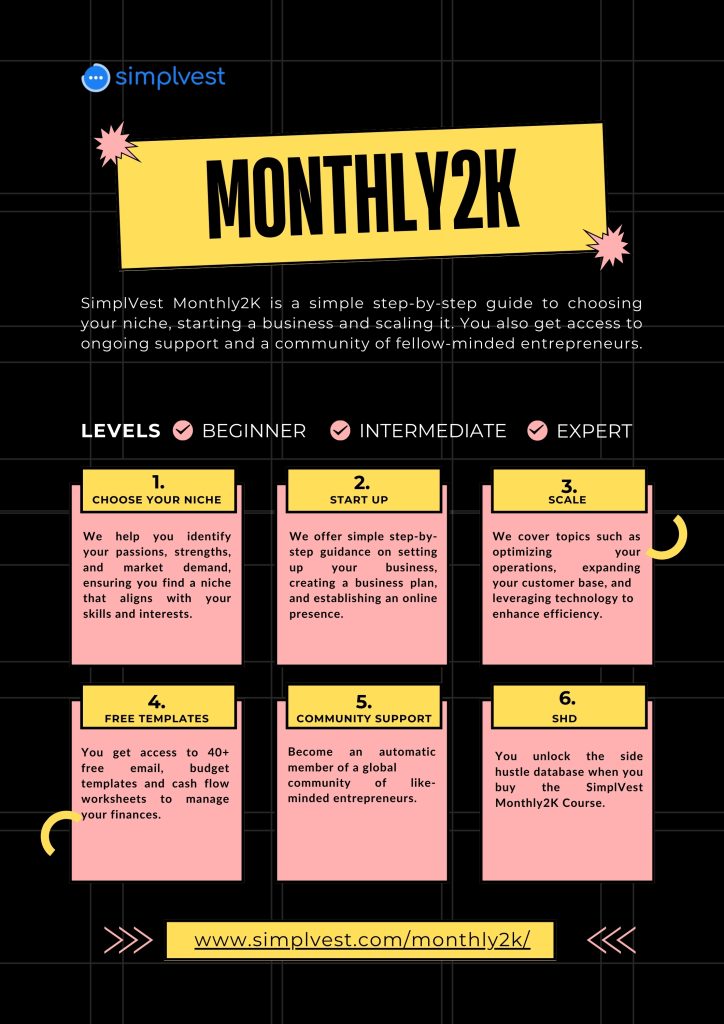Successfully scaling a business or side hustle from a passion project to a profitable business requires more than just hard work. It demands strategic planning and a deep understanding of growth dynamics.
This guide recommends actionable ways for scaling your business or side hustle.

Analyzing Your Performance Metrics
Before initiating plans to scale, it’s essential to assess where your side hustle or business stands performance-wise. This involves tracking and analyzing key performance indicators (KPIs) that provide a comprehensive view of your business’s health and its potential for scalability. According to McKinsey, only 22% of new businesses successfully scale, often due to a lack of foundational metrics during early stages.
Let’s break down the essential metrics:
1. Financial Metrics
Financial metrics are the backbone of scalability that ensure you have the resources to grow:
- Revenue Growth Rate: Your RGR shows how much your revenue has increased over time. A consistent positive growth rate is a sign of a healthy business. It is essential for reinvestment. It is calculated as (Current Period Revenue – Previous Period Revenue) / Previous Period Revenue ×100,
- Profit Margin: Your profit margin indicates how much of your revenue is converted into profit. According to Harvard Business Review, small businesses typically perform well with a profit margin between 10% and 20%, though benchmarks can vary by industry. It is calculated as (Net Income / Revenue) ×100.
- Cash Flow: Monitoring your operating cash flow ensures that you have enough liquidity to cover expenses and invest in growth. A negative cash flow can quickly derail your scaling efforts, as it limits your ability to handle increased demand.
2. Customer Metrics
Customer metrics reveal how well you’re attracting and retaining your audience and is critical for sustainable growth:
- Customer Acquisition Cost (CAC): Your CAC should be significantly lower than your Customer Lifetime Value (CLV) for profitability. A ratio of at least 1:3 (CLV:CAC) is often recommended. it is calculated as Total Marketing and Sales Costs / Number of New Customer Acquired
- Customer Lifetime Value (CLV): Your CLV is an estimation of the total revenue from a single customer. A high CLV indicates loyal, valuable customers and is essential for scaling. It is calculated as (Average Purchase Value × Average Purchase Frequency) × Average Customer Lifespan
- Customer Retention Rate: Your customer retention rate should ideally be at least 80% if you are considering scaling, though industry standards vary. It is calculated as ((CE – CN) / CS) × 100, where CE is the number of customers at the end of the period, CN is the number of new customers acquired, and CS is the number of customers at the start.
3. Operational Metrics
Operational metrics show how optimized your business processes are to handle growth:
- Conversion Rate: This measures how effectively you’re turning leads into customers. A conversion rate of 2-5% is often considered good for e-commerce, but this can vary by industry. It is calculated as (Number of Sales / Number of Leads) × 100.
- Average Order Value (AOV): The AOV is calculated as Total Revenue / Number of Orders. AOV can be increased through upselling (e.g., offering premium packages) and cross-selling (e.g., suggesting complementary products).
- Inventory Turnover (for product-based businesses): This metric shows how efficiently you’re managing inventory. A higher turnover rate is generally better, though it depends on industry norms. This metric is calculated as Cost of Goods Sold / Average Inventory
Scenario
Consider a freelance graphic designer, Sarah, who has been running her side hustle for a year and wants to scale. She analyzes her metrics:
- Financial Metrics: Her revenue grew by 20% over the past six months, with a profit margin of 30%, which is healthy. However, her cash flow is tight due to reinvesting in marketing and software.
- Customer Metrics: Her CAC is $100 per new client, and her CLV is $1,000, giving a 10:1 ratio, excellent for scalability. Her retention rate is 70%, indicating room for improvement.
- Operational Metrics: Her conversion rate is 20%, and her AOV is $500 per project.
From this, Sarah’s scaling strategy would most likely be to focus on improving her conversion rate for instance, by refining her sales pitch and and increasing her AOV by offering premium design packages to boost revenue without necessarily acquiring more clients.
How to Identify Growth Opportunities Ahead of Expanding Your Reach
Once you understand your performance, it’s now time to explore opportunities for growth. Scaling isn’t just doing more of the same, it’s about expanding your reach, diversifying offerings and optimizing operations. McKinsey identifies seven core scaling dimensions, including product and strategy, go-to-market and operating model, with top performers excelling in practices like customer insights and scalable processes.
Here are key strategies:
1. Market Expansion
- Geographic Expansion: To expand into new markets, you may consider selling to new cities, states, or countries. Research local regulations and cultural differences to tailor your offerings. For example, a U.S.-based online store might expand to Canada.
- New Customer Segments: You can also identify underserved segments within your current market as expansion targets. If you currently target individuals, consider businesses, or vice versa, to broaden your audience.
2. Product/Service Expansion
- Complementary Products/Services: You may consider incorporating and offering products or services that naturally pair with your current offerings. For instance, a web design agency might add SEO services.
- Product Line Extension: Here, you create variations of existing products to appeal to different needs. A coffee roaster, for example, might offer different roast levels or flavoured beans to attract diverse customers.
3. Channel Expansion
- New Sales Channels: Explore marketplaces like Amazon or Etsy, or consider wholesale opportunities. This can increase visibility and help you reach new audiences.
- Marketing Channels: Experiment with new platforms or strategies, such as influencer marketing or content marketing on platforms like Instagram or TikTok, to boost brand awareness.
4. Strategic Partnerships
- Complementary Businesses: You can partner with businesses serving the same customer base but not competing directly. A wedding photographer might partner with a wedding planner, and share referrals and co-create value for each other.
- Co-branded Products: You might collaborate with another brand to create unique offerings. For example, a local brewery might partner with a bakery to create beer-flavoured bread, and appeal to both audiences.

Scenario
Take John, who owns a successful local bakery. He wants to scale and explores growth opportunities:
- Market Expansion: He may considering delivering to neighbouring towns, expanding his geographic reach.
- Product/Service Expansion: He can introduce gluten-free and vegan baked goods to cater to dietary preferences.
- Channel Expansion: He may choose to set up an online store for nationwide sales and partners with local cafes to distribute his products.
- Strategic Partnerships: He may seek collaborating with a local coffee roaster for co-branded coffee and pastry packages.
Scaling Strategies and Reinvestment
Scaling your business or side hustle requires not only identifying opportunities but also implementing strategies to support growth. This includes reinvesting your profits, securing additional funding and ensuring operations can handle increased demand. McKinsey highlights that scaling success often hinges on adapting operating models, talent strategies, and processes, with 65% of portfolio company failures attributed to people and organizational issues. Let’s explore:
1. Reinvestment Strategies
- Technology and Automation: Invest in tools like customer relationship management (CRM) software or accounting systems to automate repetitive tasks, freeing up time for strategic growth.
- Marketing and Advertising: Increase your marketing budget to reach a wider audience. Experiment with new channels, such as paid ads or influencer partnerships, to test what drives results.
- Inventory and Equipment: For product-based businesses, invest in larger inventory to meet demand or upgrade equipment for efficiency. For example, a craft seller might invest in bulk materials to reduce costs.
- Talent Acquisition: Hire employees or contractors to handle increased workload. Equip your team for growth by investing in targeted training and skill development.
2. Funding Your Business’ Growth
- Bootstrapping: Reinvest all profits back into the business. This maintains control but may limit growth speed, suitable for those preferring autonomy.
- Loans: Consider small business loans, such as SBA loans or lines of credit, for larger investments. This can accelerate growth but adds debt.
- Investors: For rapid scaling, bring on investors, but be prepared to give up some control. This is common in tech startups but less so for side hustles.
3. Scaling Operations
- Standardize Processes: Document key processes to ensure consistency as you grow. Create training materials for new team members to maintain quality.
- Build Systems: Implement scalable systems for customer service, fulfilment, etc. Use technology, like project management tools, to manage complexity.
- Outsource Non-Core Functions: Focus on core competencies and outsource others, such as accounting or IT support, to freelancers or specialized providers.
Scenario
Consider Kemi, a freelance writer with a steady client base, who is looking to scale:
- Reinvestment Strategies: She invests in a project management tool to handle multiple clients and hires a virtual assistant for administrative tasks.
- Funding Growth: She bootstraps by reinvesting profits into marketing and professional development, maintaining control.
- Scaling Operations: She standardizes her writing process with templates and outsources editing to freelancers, focusing on writing.
These steps, allow Maria to handle more work without sacrificing quality.
Growing Smarter, Not Just Bigger
Scaling your business or side hustle is an exciting phase that requires careful planning and strategic decision-making. By analyzing performance metrics, identifying growth opportunities and implementing effective scaling strategies, you can take your business to new heights. Remember, scaling is not just about getting bigger, it’s about growing smarter and focusing on sustainable growth that aligns with your long-term vision.

Ready to gain expert insights into ways of successfully scaling your business or side hustle?
Our SIMPLVEST MONTHLY2K Course gives you the step-by-step blueprint to start and grow a business. With it, you will learn in 10 actional modules, how to validate ideas, launch efficiently and scale smartly just like the pros. The first two modules are free, so you can start risk-free. When you buy it, you get additional materials, including a database of 100+ side hustles to choose from, access to a community of entrepreneurs and marketing templates, all for free.












